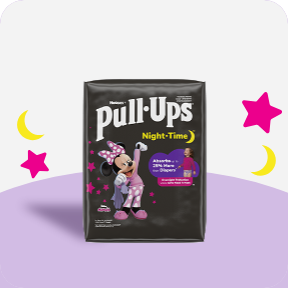How to Potty Train
Potty Training Words, Tone and Voice
18 Jan, 2023
3.5 min. Read
Does your family say doo doo or poopie? Tinkle or wee wee? Or do you use more formal words for what happens in the bathroom like urinate and have a BM? The words your family chooses are up to you.
But what’s important as you start exploring how to potty train is establishing a consistent way to talk about what your child will be experiencing. Read on for some things to consider as you figure out how to talk to a toddler in the bathroom.Every family has its own potty language. And if you say pee pee, tinkle, wee wee or piddle, that’s just fine (even if you feel a little silly at times!). Some experts advise parents to always use the technical, anatomically correct terms for body parts and functions.
Others disagree, saying that part of the joy of raising children is the silliness — including the crazy kitchen dances we do and the unique words that make up our family traditions. Using silly words can help make sometimes tedious and challenging care-taking tasks, like helping a small child use the toilet, a lot more fun for both parent and child.
Remember that whatever words you choose, it’s important to keep them consistent and keep the conversation open so you and your toddler feel comfortable talking about this important journey. Now fingers crossed you don’t accidentally say “I need to make a poopie” when excusing yourself from a table full of grownups!
But what’s important as you start exploring how to potty train is establishing a consistent way to talk about what your child will be experiencing. Read on for some things to consider as you figure out how to talk to a toddler in the bathroom.Every family has its own potty language. And if you say pee pee, tinkle, wee wee or piddle, that’s just fine (even if you feel a little silly at times!). Some experts advise parents to always use the technical, anatomically correct terms for body parts and functions.
Others disagree, saying that part of the joy of raising children is the silliness — including the crazy kitchen dances we do and the unique words that make up our family traditions. Using silly words can help make sometimes tedious and challenging care-taking tasks, like helping a small child use the toilet, a lot more fun for both parent and child.
So choose what feels right. The more natural the words are for you, the more comfortable your child will feel.
Tone Is What Really Matters
What’s more important than the actual words we use is how we say them. Using a humiliating, belittling or aggravated tone of voice with your potty trainee may result in a child who feels a sense of shame and embarrassment about their body, regardless of the actual words we say. Adopting a communication style that is matter-of-fact and accepting will convey comfort and confidence to your child. So go ahead and use whatever reasonably appropriate names you want for body parts and functions — all the better if your child helps to create them. Toddler potty training is a collaboration between you both, after all!Collaborating with Caregivers
It’s OK if your child’s preschool teacher or babysitter uses different words than you do — if they say “piddle” and you say “pee,” for example — as long as your child is comfortable using those words. It helps for everyone to know each other’s words, of course. And it’s definitely important to use the same potty training techniques so your child has a consistent experience at home and at daycare — so the big transition to using the potty doesn’t become any more confusing than it has to be.Think About Your Child’s Personality
While every child is unique – in potty training and so many other ways – we have identified five different potty training personalities. Take this quick quiz to find out your child’s potty personality and learn what you should keep in mind as you’re tailoring your potty training approach to fit their needs. Then find the right tone and some sample potty training talk here:- Eager-to-please. These kids are naturally energetic and do well with praise. They thrive on positive feedback and are incentivized by rewards. When potty training, they’ll want to do things the right way and will be thrilled to know you’re proud of them. The “Can You Do What I Do?” game works really well with these kids. When talking about potty training, try potty training phrases like these:
- “I’m going to the potty. Want to keep me company?”
- “Let’s go to the park. But first, everyone has to go to the potty.”
- “I’m going to the potty. Want to keep me company?”
- “Let’s go to the park. But first, everyone has to go to the potty.”
- Shy. Shy kids are likely to feel most comfortable using the potty where there’s an established routine such as at school or in their home. They’re less comfortable in new settings. With a shy child, it’s important to be more casual as you introduce a potty. Let them lead the way, and give them as much time as needed to adjust. If you’re too pushy, they might retreat. Here are a few things you can say:
- “Hey, want to try flushing the toilet, just for fun? Let’s see what happens when it swooshes.”
- “Try sitting backwards on the big potty — facing the tank. That will help you feel safer.”
- “Hey, want to try flushing the toilet, just for fun? Let’s see what happens when it swooshes.”
- “Try sitting backwards on the big potty — facing the tank. That will help you feel safer.”
- High-energy. These kids are always on the go — and taking time to stop and try the potty can sometimes be a challenge. If you have a high-energy kid, keep your discussions about the potty short and skip the details. Make sure you create a fun atmosphere in the bathroom so your toddler stays engaged. You could start by trying statements like these:
- “Race you to the bathroom! Potty time!
- “Let’s sing a silly song about potties while you wait for the poop to come out.”
- “Race you to the bathroom! Potty time!
- “Let’s sing a silly song about potties while you wait for the poop to come out.”
- Cautious. Toddlers with a cautious personality notice everything around them and want to know the details. With a cautious child, it’s important to explain how the toilet works and what to expect. Your child might even want to teach someone else what they’ve learned. Cautious children will have high expectations for themselves, so it’s important to help them be flexible and appreciate their successes. Use specific, thoughtful words such as:
- “Next time you poop in the potty, which kind of animal cracker will you pick for your treat?”
- “Want to show your stuffed animal how you’re using the Big Kid potty?
- “Next time you poop in the potty, which kind of animal cracker will you pick for your treat?”
- “Want to show your stuffed animal how you’re using the Big Kid potty?
- Free-spirited. Kids who are free spirited would much rather be playing and exploring than patiently sitting on the potty. With this personality, it’s important to make sure your child is ready before you introduce the idea of potty training. Then, when you’re both ready, make sure potty time is fun. You’ll probably have to remind your toddler to flush and wash their hands, but eventually they’ll remember the details. Keep words like these in mind:
- “Time to use the potty! When you’ve tried, you can go outside to play!”
- “Let’s create a cheer we can do together each time you pee or poop in the potty.”
- “Time to use the potty! When you’ve tried, you can go outside to play!”
- “Let’s create a cheer we can do together each time you pee or poop in the potty.”


























